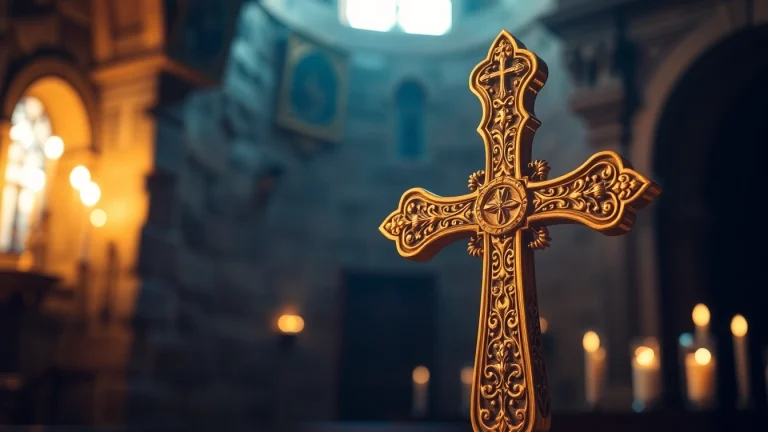
The Symbolism and History Behind Jerusalem Crosses
What are Jerusalem Crosses?
The Jerusalem crosses serve as a prominent symbol in Christian heritage, embodying a unique design and historical significance. Typically, this heraldic cross consists of a large central cross, often depicted as potent, surrounded by four smaller Greek crosses—one in each quadrant. Each element of this design is laden with rich symbolism that speaks to the essence of Christianity and the history of the region it represents. This article explores the intricate facets of the Jerusalem crosses, including their design, historical context, spiritual implications, and modern-day applications.
Understanding the Design and Elements
The design of the Jerusalem cross is both striking and meaningful. The central large cross represents the primary Christian faith, while the four smaller crosses symbolize the four evangelists—Matthew, Mark, Luke, and John. This aspect of the design signifies the spreading of the Gospel message throughout the four corners of the earth, a mission rooted in the teachings of Jesus Christ. Each small cross is often interpreted as a reminder of the diverse audiences to which the message was delivered, reflecting a universal outreach that transcends cultural and geographical boundaries.
The visual impact of the Jerusalem cross is amplified by its potent style; the arms of the central cross are often emphasized, making them broader than the surrounding smaller crosses. This distinctive appearance sets the Jerusalem cross apart from other cross designs, creating a powerful emblem that is instantly recognizable. Its origins can be traced back to the 11th century, a time steeped in religious significance and crusading history, where it emerged as a rallying symbol for the Crusaders and the Kingdom of Jerusalem.
Historical Context and Origin
The Jerusalem cross first became prominent during the Crusades when it was adopted as a symbol by the Knights of the First Crusade. This emblem reflected both their mission and the sanctity of their cause as they sought to reclaim Jerusalem and the Holy Land. Historical records suggest that it was during this time when the significance of the Jerusalem cross deepened, becoming associated with the religious fervor that characterized the Crusaders’ journey. The cross not only served as a spiritual banner but also represented the aspirations of a kingdom focused on spreading Christianity across the regions they encountered.
Over the centuries, the Jerusalem cross has manifestly evolved, maintaining its significance throughout various periods, especially during the establishment of the Latin Kingdom of Jerusalem, where it became an emblem of sovereignty and the Christian faith in the Holy Land. It has been used by various religious groups throughout history and remains a respected symbol in both ecclesiastical settings and popular Christian culture.
Differences from Other Cross Styles
While many crosses serve as powerful illustrations of Christian faith, the Jerusalem cross distinctly stands apart from others due to its unique structure and historical resonance. For instance, unlike the more common Latin cross, which consists of a single long vertical beam intersected by a shorter horizontal beam, the Jerusalem cross includes the additional four smaller crosses, which significantly enhance its symbolic depth.
Similarly, the Jerusalem cross can also be differentiated from the Celtic cross, characterized by its circular halo surrounding the intersection of the vertical and horizontal beams. This stylistic choice represents eternal life and the encirclement of divinity, while the Jerusalem cross strategically emphasizes the role of the evangelists and the diffusion of Christianity from Jerusalem to all directions.
Understanding these differences enables a deeper appreciation for the cultural and spiritual narratives woven into the fabric of various cross designs and highlights the Jerusalem cross’s unique position within Christian symbology.
The Symbolic Meaning of Jerusalem Crosses
The Jerusalem cross is not merely an ornamental design; it encompasses significant cultural and religious meanings that resonate deeply within the Christian faith. Each aspect of its appearance is imbued with layers of spiritual significance that transmit messages of faith, responsibility, and the call to action for believers around the world.
Cultural and Religious Significance
The cultural significance of the Jerusalem cross transcends geographic boundaries, making it an emblem of unification among various Christian sects. Beyond its historical roots, the cross evolves as a badge of faith for many Christians who also view it as a reminder of their duty to evangelize—to spread the teachings of Christ.
Culturally, the Jerusalem cross is often associated with the spirit of pilgrimage. Many believers wear it as an expression of their commitment to their faith, as well as a way to honor the journeys made by those who sought to visit the Holy Land. This connection between the emblem and the broader context of Christian pilgrimage highlights the integral nature of the symbol to both personal faith journeys and the shared history of the Christian community.
Representation of the Four Evangelists
The four smaller crosses surrounding the large central cross symbolize the four evangelists: Matthew, Mark, Luke, and John. Each evangelist is traditionally associated with distinct qualities that are encapsulated within the Gospel they authored, leading to a multifaceted representation of the Christian narrative. Matthew is often depicted as a man, illustrating Christ’s incarnation; Mark as a lion, representing resurrection; Luke as an ox, symbolizing sacrifice; and John as an eagle, signifying spiritual elevation and divine inspiration.
By incorporating these four figures into its design, the Jerusalem cross serves as a visual reminder of the foundational texts of Christianity, encouraging believers to engage with the scriptures continually. It prompts both reflection on the words of Christ and a call to embody the lessons of His life, providing pathways for moral living and spiritual growth.
Wider Spiritual Implications
The Jerusalem cross extends its implications beyond literal interpretation, creating an avenue for contemplating the spread of Christianity across different cultures and peoples. This dynamic reflects a call for inclusivity—an invitation for believers to embrace diversity while remaining anchored in their faith.
Additionally, the spiritual resonance of the Jerusalem cross extends to themes of sacrifice, love, and redemption—themes that are essential to the experience of faith. The cross invites individuals to engage with and embrace their roles in a broader narrative of salvation, reflecting on how their lives contribute to the ongoing story of Christianity in contemporary society.
Ultimately, the Jerusalem cross thus operates on both personal and communal levels, encouraging believers to think of themselves within the context of the global church and inspiring actions that contribute to the propagation of hope and love.
How to Incorporate Jerusalem Crosses in Modern Wear
As the Jerusalem cross transcends its historical roots, it finds modern expression through various forms of jewelry and home décor, allowing individuals to integrate its symbolic significance into their daily lives. This section examines how the Jerusalem cross can be stylishly worn and displayed in contemporary settings.
Jewelry and Fashion Trends
Jewelry designs featuring the Jerusalem cross have become increasingly popular among fashion-conscious believers looking to express their spirituality. Contemporary interpretations often include minimalist designs, which can be elegantly worn as necklaces, bracelets, or earrings. These fashionable accessories not only celebrate individual faith but also spark conversations about spirituality and beliefs.
For instance, wearing a Jerusalem cross pendant can serve dual purposes: it is a statement of personal faith and a way to encourage others to explore the meaning behind this rich symbol. In light of their unique design, Jerusalem crosses can easily be incorporated into various fashion styles—from casual to formal attire—creating an inviting appearance that resonates with both personal identity and spiritual allegiance.
Art and Home Decor
The use of the Jerusalem cross extends seamlessly to art and home décor items as well. Many artisans create stunning pieces featuring this emblem, often employing traditional artistic techniques that highlight the craftsmanship and cultural significance of the symbol. For example, wall art displaying the Jerusalem cross may be depicted using a variety of materials, from wood to canvas, making it suitable for diverse interior aesthetics.
Incorporating the Jerusalem cross into home settings allows individuals to express their values and faith while creating a focal point that invites reflection and discussion. This practice enhances personal living spaces with deeper meaning by reminding residents and guests of the broader narrative that transcends individual experiences.
Choosing Authentic Craftsmanship
When selecting Jerusalem crosses for jewelry or home décor, authenticity is key. Through careful consideration of the materials used, craftsmanship techniques, and the cultural context of the items, individuals can ensure they are choosing pieces that genuinely represent the rich heritage of the symbol. Supporting skilled artisans who honor traditional methods of creation not only contributes to preserving culture but also promotes ethical consumption practices.
Moreover, individuals seeking to purchase these items should consider their sources and verify that they align with the principles of authenticity and respect for the Jerusalem cross’s historical and spiritual significance. Through this discernment process, consumers can contribute positively to the sustenance of authentic craftsmanship and cultural storytelling.
Purchasing Jerusalem Crosses: A Guide
In light of the numerous options available for acquiring Jerusalem crosses, it’s essential to navigate the marketplace with care. This section serves as a comprehensive guide to help individuals find quality, authentic Jerusalem crosses while understanding the intricacies involved in making informed purchasing decisions.
Finding Reputable Sellers
As the popularity of the Jerusalem cross has surged, numerous sellers have emerged in the marketplace. When seeking reputable sellers, it is advisable to prioritize shops or artisans known for their commitment to quality and authenticity. Look for online reviews, testimonials, and industry certifications that validate the seller’s credibility.
In addition to customer feedback, engaging with sellers who provide detailed information about their sourcing, materials, and craftsmanship can also guide buyers toward making informed choices. Establishing a direct connection with artisans or sellers allows for a richer understanding of the pieces and their significance, often enhancing the purchasing experience.
Factors to Consider When Buying
In the process of purchasing Jerusalem crosses, there are several critical factors to consider. Understanding the size, design, and material of the cross can significantly impact the final purchase decision. Larger crosses may serve as statement pieces, while smaller designs can function as subtle expressions of faith.
Moreover, evaluating materials is essential; precious metals, wood, or glass each carry distinct qualities that influence aesthetics and durability. Travelers and artisans from the Holy Land often produce Jerusalem crosses from olive wood, making these items unique and culturally vibrant. Buyers should weigh the significance of the materials chosen, as they contribute to the overall narrative behind the piece.
Care and Maintenance Tips
Once a Jerusalem cross has been purchased, proper care is crucial to maintain its integrity and beauty. For jewelry, routine polishing and careful storage can help preserve the quality of the materials used. Keeping jewelry free from excessive moisture and avoiding exposure to harsh chemicals will prolong its lifespan significantly.
Similarly, for decorative Jerusalem crosses, cleaning and dusting can ensure they remain a vibrant focal point in the home. Depending on the material, specific care instructions should be followed to avoid deterioration over time. By incorporating these practices, individuals can uphold the beauty and significance of their Jerusalem crosses.
Exploring Common Misunderstandings
Despite its historical and spiritual prominence, the Jerusalem cross is often subjected to various misunderstandings that can distort its intended meaning. This section aims to clarify common misconceptions and provide a more accurate interpretation of the symbol.
Debunking Myths Surrounding Jerusalem Crosses
Several myths might arise surrounding the Jerusalem cross, including misinterpretations of its design and significance. One prevalent myth is that the cross is solely a symbol of the Crusades. While having origins related to this historical period, the Jerusalem cross is much more than a mere representation of warfare; it serves as a symbol of faith and evangelism, transcending its association with conflict.
Another common misunderstanding is that the Jerusalem cross is a nationalistic symbol. While it does evoke connections to the geographic and historical region of Jerusalem, its primary role is as a spiritual emblem that celebrates a collective Christian identity rather than fostering division based on nationalism or ethnicity.
Clarifying Cultural Appropriation Concerns
Recent discussions around cultural appropriation revisit how symbols like the Jerusalem cross are utilized in various contexts. It is important to approach the use of the cross with sensitivity and respect, ensuring a deep understanding of its cultural and religious significance is recognized when worn or represented.
Those who choose to incorporate Jerusalem crosses into their lives or styles should engage with the symbol authentically, genuinely appreciating its roots and the narratives it encapsulates rather than merely adopting it as a fashionable accessory. Awareness and respect are pivotal in valuing cultural symbols in a manner that honors their origins.
Interpreting Symbolism Accurately
Accurate interpretation of the Jerusalem cross involves understanding the depth of its symbolism. By appreciating its components—the central cross representing Christ and the smaller crosses signifying the four evangelists—individuals can grasp the encompassing story of faith, outreach, and the transformative power of love that lies at the heart of Christianity.
Moreover, recognizing the communal aspect of the Jerusalem cross fosters a sense of responsibility among believers to embody the tenets of their faith. This understanding encourages individuals to participate actively in the spread of love, hope, and compassion, making the Jerusalem cross not only a personal emblem of faith but also a call to action for a greater good.


